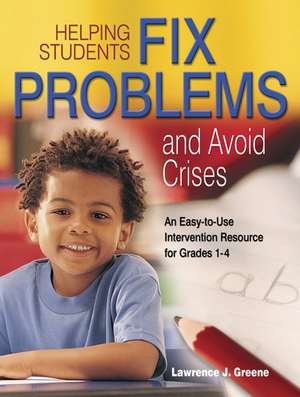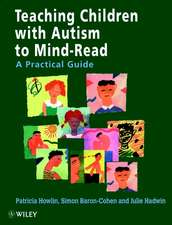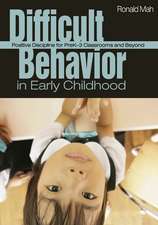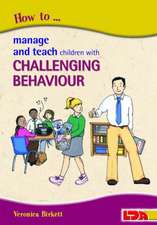Helping Students Fix Problems and Avoid Crises: An Easy-to-Use Intervention Resource for Grades 1-4
Autor Lawrence J. Greeneen Limba Engleză Paperback – 2 aug 2005
- modeling solutions
- structuring opportunities for practice
- providing feedback
- and affirming progress.
The book offers units covering topics that include the child who doesn't have friends, who does poorly in sports, who has difficulty learning, who steals, who tells lies, who bullies others. Each unit provides a succinct discussion of the topic for the educator, a 10-minute read-aloud story, strategic thinking questions, optional paper-and-pencil activities, and photocopiable exercises.
The book includes two appendices to guide the teacher through more complex psychological problems and psychological overlay, which may require referral and counselling. This book will be an essential resource for every primary teacher who wants to help guide learners through many of the developmental challenges of childhood.
Preț: 304.24 lei
Nou
Puncte Express: 456
Preț estimativ în valută:
58.21€ • 60.95$ • 48.17£
58.21€ • 60.95$ • 48.17£
Carte tipărită la comandă
Livrare economică 07-21 aprilie
Preluare comenzi: 021 569.72.76
Specificații
ISBN-13: 9781412904704
ISBN-10: 1412904706
Pagini: 200
Dimensiuni: 216 x 279 x 11 mm
Greutate: 0.48 kg
Ediția:New.
Editura: SAGE Publications
Colecția Corwin
Locul publicării:Thousand Oaks, United States
ISBN-10: 1412904706
Pagini: 200
Dimensiuni: 216 x 279 x 11 mm
Greutate: 0.48 kg
Ediția:New.
Editura: SAGE Publications
Colecția Corwin
Locul publicării:Thousand Oaks, United States
Recenzii
“Provides a sequential method for teaching the skills children need to help themselves. . . I can see where this book will be one that is dog-eared and never just sitting on the shelf.”
“This book offers real steps for helping empower kids. The lessons are designed so that all children within a classroom would benefit, whether they are the child for whom the lesson was designed or the one for whom the lesson will build empathy, compassion, and understanding. Most books are not user friendly, providing off-the-shelf lessons. Mr. Greene has taken a truly easy-to-use methodical approach to problems kids face that can become a pivotal point in turning them around at an earlier age.”
“Very practical and usable units, easy to understand and carry out. . . . Child-centered and internally empowering for the student.”
"I appreciate the book's informal tone and the flow of material. It is very readable; free of complicated psychobabble and excessive jargon. Although teachers get classroom management in the education curriculum, the strategies are laced with common sense that often gets passed over in the general education curriculum. (The) writing is clear: stories are useful and appropriate to the content area discussed, table of contents is comprehensive; exercises are helpful."
"A welcome intervention guide for teachers in the early grades. This book is a valuable tool with ideas that can be implemented within language arts, social studies, or health curriculum."
“This book offers real steps for helping empower kids. The lessons are designed so that all children within a classroom would benefit, whether they are the child for whom the lesson was designed or the one for whom the lesson will build empathy, compassion, and understanding. Most books are not user friendly, providing off-the-shelf lessons. Mr. Greene has taken a truly easy-to-use methodical approach to problems kids face that can become a pivotal point in turning them around at an earlier age.”
“Very practical and usable units, easy to understand and carry out. . . . Child-centered and internally empowering for the student.”
"I appreciate the book's informal tone and the flow of material. It is very readable; free of complicated psychobabble and excessive jargon. Although teachers get classroom management in the education curriculum, the strategies are laced with common sense that often gets passed over in the general education curriculum. (The) writing is clear: stories are useful and appropriate to the content area discussed, table of contents is comprehensive; exercises are helpful."
"A welcome intervention guide for teachers in the early grades. This book is a valuable tool with ideas that can be implemented within language arts, social studies, or health curriculum."
Cuprins
Introduction
Being Attuned
Can I Really Do It?
How the Program Works
Acknowledgments
About the Author
Unit 1: The Child Who Doesn't Have Friends
For Educators: Examining the Dynamics and Implications of Social Rejection
Struggling With Seemingly Insoluble Problems
The Nuts and Bolts of Self-Esteem
Identifying and Expressing Feelings
Concept and Application
Developing Analytical Thinking Skills
Key Objectives for Enhancing Students' Awareness
Can Children Be Taught to Be More Empathetic?
Examining the Story
The Questions That Follow the Story
Cause-and-Effect Principles
Brainstorming
Getting Started
For Students: The Child Who Doesn't Have Friends
The Story
Oral Questions
Optional Activity: Careful Reading and Analysis of the Story
Supplemental Reproducible Exercises
Follow-Up and Application
Additional Concrete Reinforcements
Unit 2: The Child Who Has Difficulty Learning
For Educators: Examining the Emotional Implications of Learning Problems
The Effects of Learning Differences
Conduct Commonly Associated With Learning Problems
Classroom Scripts
Restrictive Assessment Criteria
Identifying and Applying Multiple Intelligences
Learning Preferences
Identifying Preferred Learning Modalities
Learning Modality Inventory
Interpreting the Survey
Using Dominant and Preferred Learning Modalities
Examining the Story
The Questions That Follow the Story
For Students: The Child Who Has Difficulty Learning
The Story
Oral Questions
Optional Activity: Careful Reading and Analysis of the Story
Supplemental Reproducible Exercises
Follow-Up and Application
Concrete Reinforcements
Unit 3: The Child Who Steals
For Educators: Examining the Dynamics and Implications of Stealing
Common Explanations for Stealing
An Alternative to the Traditional Adult Responses to Stealing
Examining the Story
The Questions That Follow the Story
For Students: The Child Who Steals
The Story
Oral Questions
Optional Activity: Careful Reading and Analysis of the Story
Supplemental Reproducible Exercises
Follow-Up and Application
Concrete Reinforcements
Unit 4: The Child Who Tells Lies
For Educators: Examining the Dynamics and Implications of Lying
Training Children to Be Truthful
Expanding the List of Explanations for Lying
Traditional Adult Responses to Lying
The Role of the Teacher
Examining the Story
The Questions That Follow the Story
For Students: The Child Who Tells Lies
The Story
Oral Questions
Optional Activity: Careful Reading and Analysis of the Story
Supplemental Reproducible Exercises
Follow-Up and Application
Concrete Reinforcements
Unit 5: The Child Who Is a Bully
For Educators: Examining the Dynamics and Implications of Bullying
Power as a Surrogate Social Acceptance
Training Children to Be Kind
The Role of the Teacher
Examining the Story
The Questions That Follow the Story
For Students: The Child Who Is a Bully
The Story
Oral Questions
Optional Activity: Careful Reading and Analysis of the Story
Supplemental Reproducible Exercises
Follow-Up and Application
Concrete Reinforcements
Unit 6: The Child Who Does Poorly in Sports
For Educators: Examining the Implications of Being Poorly Coordinated
The Ethos of Sports
The Consequences of Poor Coordination
Antidotes for Athletic Insufficiencies
Examining the Story
The Questions That Follow the Story
For Students: The Child Who Does Poorly in Sports
The Story
Oral Questions
Optional Activity: Careful Reading and Analysis of the Story
Supplemental Reproducible Exercises
Follow-up and Application
Concrete Reinforcements
Appendix 1: Psychological Overlay and Learning Differences
Understanding Psychological Overlay
Identifying the Symptoms of Psychological Overlay
Behaviors and Attitudes That May Indicate Psychological Overlay
Appendix 2: Psychological Problems
Red Flag Symptoms of a Possible Psychological Problem
Referral and Intervention
Index
Being Attuned
Can I Really Do It?
How the Program Works
Acknowledgments
About the Author
Unit 1: The Child Who Doesn't Have Friends
For Educators: Examining the Dynamics and Implications of Social Rejection
Struggling With Seemingly Insoluble Problems
The Nuts and Bolts of Self-Esteem
Identifying and Expressing Feelings
Concept and Application
Developing Analytical Thinking Skills
Key Objectives for Enhancing Students' Awareness
Can Children Be Taught to Be More Empathetic?
Examining the Story
The Questions That Follow the Story
Cause-and-Effect Principles
Brainstorming
Getting Started
For Students: The Child Who Doesn't Have Friends
The Story
Oral Questions
Optional Activity: Careful Reading and Analysis of the Story
Supplemental Reproducible Exercises
Follow-Up and Application
Additional Concrete Reinforcements
Unit 2: The Child Who Has Difficulty Learning
For Educators: Examining the Emotional Implications of Learning Problems
The Effects of Learning Differences
Conduct Commonly Associated With Learning Problems
Classroom Scripts
Restrictive Assessment Criteria
Identifying and Applying Multiple Intelligences
Learning Preferences
Identifying Preferred Learning Modalities
Learning Modality Inventory
Interpreting the Survey
Using Dominant and Preferred Learning Modalities
Examining the Story
The Questions That Follow the Story
For Students: The Child Who Has Difficulty Learning
The Story
Oral Questions
Optional Activity: Careful Reading and Analysis of the Story
Supplemental Reproducible Exercises
Follow-Up and Application
Concrete Reinforcements
Unit 3: The Child Who Steals
For Educators: Examining the Dynamics and Implications of Stealing
Common Explanations for Stealing
An Alternative to the Traditional Adult Responses to Stealing
Examining the Story
The Questions That Follow the Story
For Students: The Child Who Steals
The Story
Oral Questions
Optional Activity: Careful Reading and Analysis of the Story
Supplemental Reproducible Exercises
Follow-Up and Application
Concrete Reinforcements
Unit 4: The Child Who Tells Lies
For Educators: Examining the Dynamics and Implications of Lying
Training Children to Be Truthful
Expanding the List of Explanations for Lying
Traditional Adult Responses to Lying
The Role of the Teacher
Examining the Story
The Questions That Follow the Story
For Students: The Child Who Tells Lies
The Story
Oral Questions
Optional Activity: Careful Reading and Analysis of the Story
Supplemental Reproducible Exercises
Follow-Up and Application
Concrete Reinforcements
Unit 5: The Child Who Is a Bully
For Educators: Examining the Dynamics and Implications of Bullying
Power as a Surrogate Social Acceptance
Training Children to Be Kind
The Role of the Teacher
Examining the Story
The Questions That Follow the Story
For Students: The Child Who Is a Bully
The Story
Oral Questions
Optional Activity: Careful Reading and Analysis of the Story
Supplemental Reproducible Exercises
Follow-Up and Application
Concrete Reinforcements
Unit 6: The Child Who Does Poorly in Sports
For Educators: Examining the Implications of Being Poorly Coordinated
The Ethos of Sports
The Consequences of Poor Coordination
Antidotes for Athletic Insufficiencies
Examining the Story
The Questions That Follow the Story
For Students: The Child Who Does Poorly in Sports
The Story
Oral Questions
Optional Activity: Careful Reading and Analysis of the Story
Supplemental Reproducible Exercises
Follow-up and Application
Concrete Reinforcements
Appendix 1: Psychological Overlay and Learning Differences
Understanding Psychological Overlay
Identifying the Symptoms of Psychological Overlay
Behaviors and Attitudes That May Indicate Psychological Overlay
Appendix 2: Psychological Problems
Red Flag Symptoms of a Possible Psychological Problem
Referral and Intervention
Index
Notă biografică
Descriere
For the child who doesn't have friends, does poorly in sports, or has difficulty learning, Greene provides solid, proven methods to help these learners succeed.








